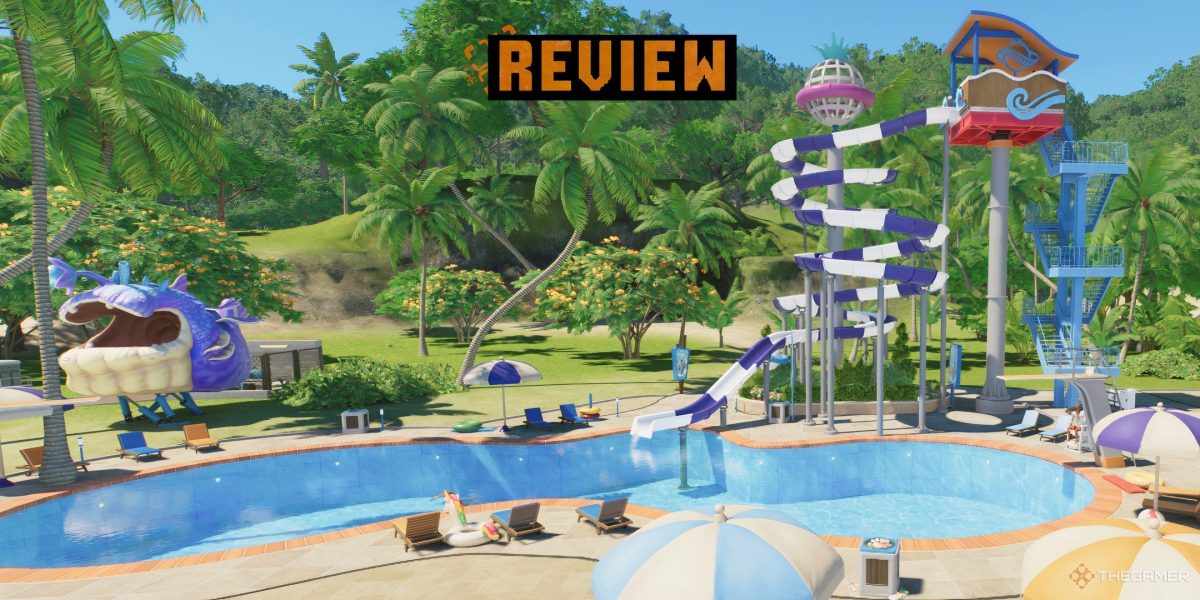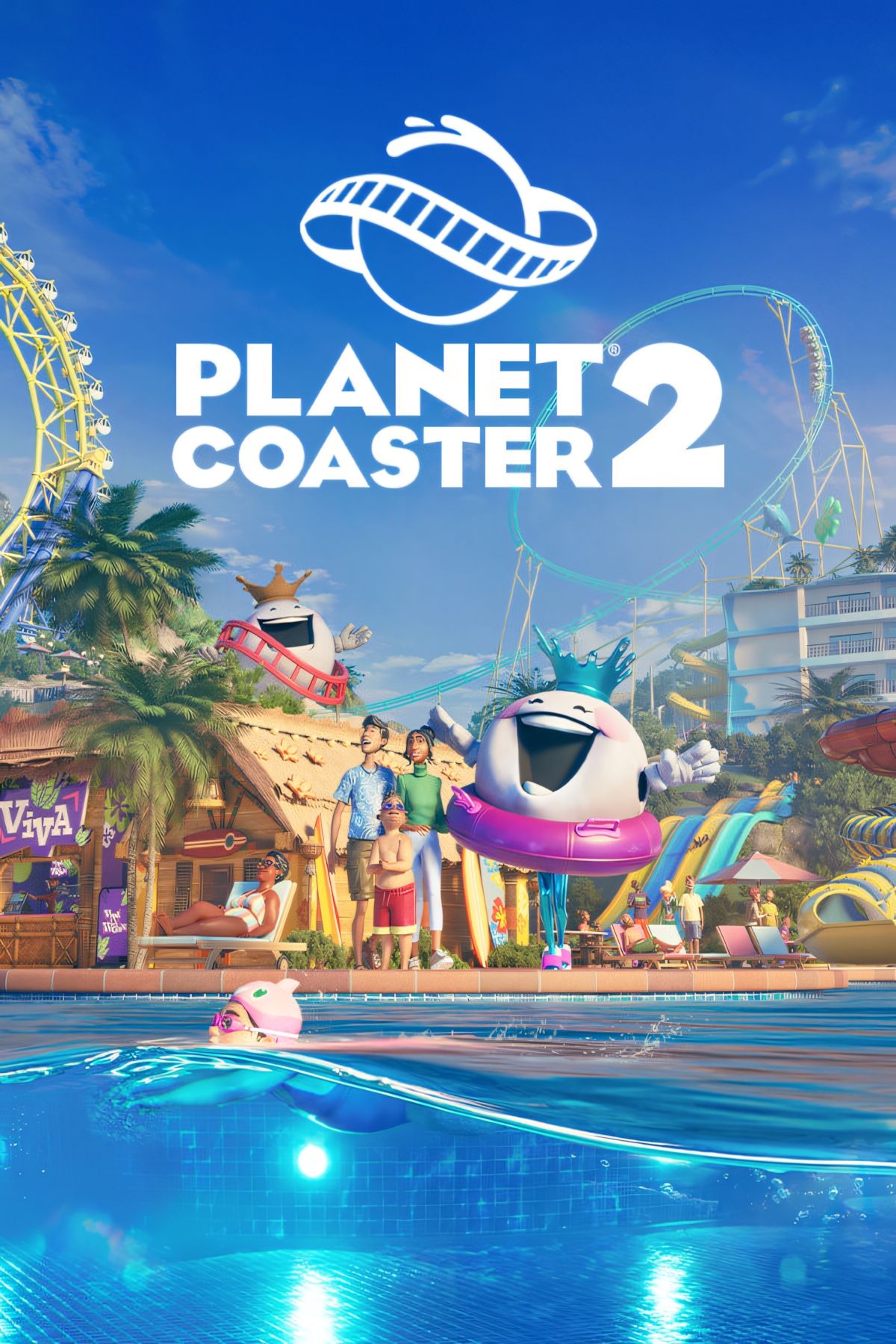
Planet Coaster 2 Review: Making A Splash
A happy customer sits on a sun lounger beside the recently assembled pool. Its creator has finally mastered the art of placing paths, and with this the fear of being eternally trapped in the changing rooms has gone. Patrons in this park roam free, able to walk across the freshly laid plaza to take a dip or laze in the sun.
Everything is quiet and serene, until suddenly the water rushing down the recently built water chute turns green. The pool quickly empties and panic ensues. It looks like the water filter isn’t working properly. Time to call maintenance… Again.
Planet Coaster 2 Brings Pools To The (Theme) Park
In Planet Coaster 2, you’ll need to get used to hitting the emergency maintenance button, as well as the ‘call janitor’ button. In fact, maybe put your hands over a few call buttons at once if you can. This long-awaited sequel is giving us more of everything, and that includes management of rides, facilities, utilities, prices, and staff. It’s also added pools and flumes to the equation, allowing you to build water or hybrid parks as well as regular theme parks.

Related
How Planet Coaster 2 Devs Used Community Feedback To Build A Stronger Sequel
We sat down with Planet Coaster 2 game director Richard Newbold to chat about how fans helped shape the game.
As a long-time fan of building simulated theme parks – since Bullfrog’s Theme Park itself in fact – I was excited to get my hands on this sequel. It was first teased back in July, and in September I finally got to play a little. I loved what I saw but I wasn’t joking when I mentioned the eternal changing room banishment, and there was also a small incident with a lazy river.
Fortunately, there’s a brief tutorial-style prologue to the career mode to get you started and then the levels themselves ease in the extra mechanics, facilities, and ride types over time. Career mode is split into four chapters, each of which is broken down into several scenarios, each with goals to meet in order to earn stars and unlock the next chapter. This is the same system as in the original, and means that you don’t have to complete every scenario in order to progress.
To understand the new systems, I recommend trying to forget everything you think you know before you start.
The flexible system worked especially well here when it came to a couple of scenarios where getting the final star was quite a leap in difficulty, as some of the parks are small, and it’s tricky to fit everything in. You’ll still find a learning curve here, but it’s lower than in the previous title.
Coaster building in particular is far more intuitive, yet also more complex. Thanks to a drag and drop style interface you can construct and edit a coaster with relative ease but it is a very different system. Mostly, it’s fairly smooth but a couple of quirks still tripped me up, such as changing the length of the piece of track. For those who understand the mechanics, there are a huge number of options to fine tune your coaster, but with some work I was able to construct a rideable solution much faster than I was in the past by simply ignoring all of these.
It sounds counterintuitive but the game has been designed with a level of micromanagement that you can opt into, but mostly don’t have to. Playing a good chunk of career mode first will also help as it involves goals that include editing and adapting half built rides and facilities across theme parks and water parks. These scenarios and goals enable you to learn the build mechanics in stages as you go and I found that my building ability and understanding of the new systems did improve faster than I expected, just by progressing through career mode.
Sandbox Adds A Flexible Dimension
There’s also a sandbox mode and, as expected, you can really unleash your creativity here in any way you desire, since almost everything can be customised. After setting the park’s biome you can choose a pre-set challenge level or a completely customisable one, and decide if you wish to manage money, utilities, staff, guests or any combination of the above. You can also decide if you want to research new rides or have everything unlocked. The true customisation means your park building experience can offer the exact level of challenge you want.
Career mode is a great place to start, and there’s a lot here you can go back to and rebuild, with many scenarios feeling like ones I’m likely to revisit once my knowledge grows. However, the sandbox is where the real beauty lies.
Sandbox mode has hugely flexible options to control almost everything and build the way you want, be that with no limits or a huge challenge.
A lot of lessons have been learned here, especially with the building tools, and while some core aspects are the same, several things have been made easier. Snapping options are more sensible, and building has been tweaked to make it a little less intimidating for the beginner. The mirror mode also allows you to design one side of any ride or building and have it copy to the other, which is incredibly helpful and eliminates a huge amount of frustration from in-depth customisation.
The addition of water park features brings a completely new dimension to proceedings, and adds huge scope to your experience. There is enough variety with the flumes, facilities, and rides that you can build your own park purely with pools and flumes as easily as you can build a traditional park.
Setting your own goals in Sandbox helps remove all the management, should you so desire, but you will still come up against it in career mode, even on lower difficulties. While the micromanagement can be bypassed in many cases, utility management can be rough at times. You’ll have to make sure everything is connected and assign staff specifically to keep your water and power maintained. Guests hating to see the facilities is still a feature, yet you’ll need to keep them very close, and while being able to research underground alternatives helps a lot, placing these can be tricky.
Overall, Planet Coaster 2 feels like a natural evolution of the first game. Lessons have been learned, features added, mechanics improved, and the customisation of difficulty across the board – career mode has flexible difficulty levels which can be set on a per-scenario basis – really helps tailor the game to your level of experience.
Water parks add a new dimension that has previously been confined only to DLC in games of this type, and the evolution of the theme makes it stand out. Planet Coaster 2 has really worked hard to build on its successes and smooth out its issues. The AI of staff can still feel a little wonky — they really need direction, or they’ll ignore the sparking power station behind them in favour of a mundane task —and guests will often bunch up and get stuck, even with wide paths, but overall the pros far outweigh the cons.
Planet Coaster 2 will take you on a new adventure that combines the charm and joy of the original with its own brand-new highs. While there are a couple of dips along the way, they are short-lived and simply part of the experience that doesn’t diminish the joy.


